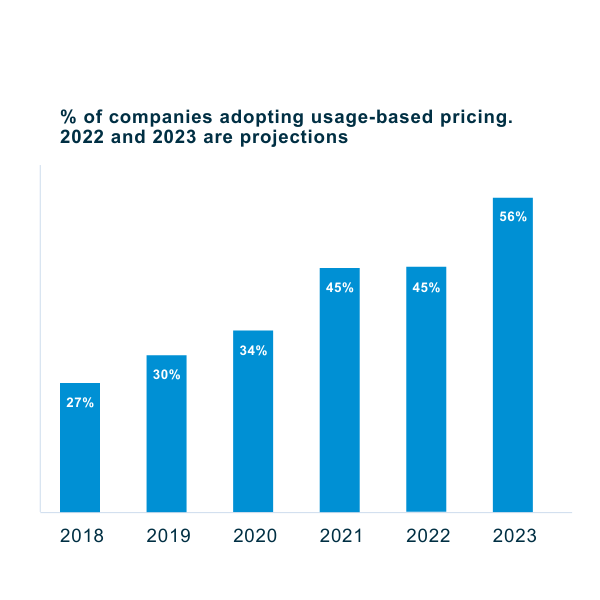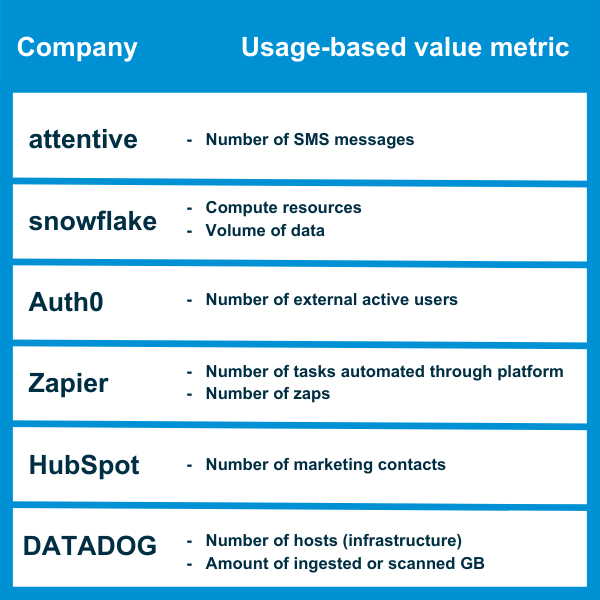Twenty years ago, you probably only paid a subscription for a gym membership, to receive magazines, or to watch premium TV channels. However, it’s now the de facto billing model for businesses of all shapes and sizes—especially software as a service (SaaS) companies.
But subscription-based models have their downsides. Companies generally offer a tiered pricing model. The more seats a user requires, the more they must pay. Except, this doesn’t necessarily make sense.
A tool’s value isn’t determined by how many people use it. Instead, it comes down to how much they use it—which is why companies need to adopt a usage-based pricing model.
Let’s examine what usage-based pricing is, dive into why it’s so valuable for both businesses and their consumers, and explore how scaling companies can take their first steps toward considering a usage-based pricing model.
What is usage-based pricing?
Usage-based pricing is straightforward. The more a customer uses a tool or service, the more they pay for it.
This is far from a new or novel concept. If you’re on a variable utility tariff (Metered billing), then you’re already following a usage-based pricing model. The more electricity or water you use, the more you pay. Likewise, it has traditionally been common in telecoms, with users paying per minute of call time or per text they send.
Usage-based pricing is now also beginning to permeate the SaaS sector. Infrastructure platforms (such as AWS and Google Cloud) initially led the way, but industry behemoths like Twilio, Shopify, and Slack have since followed suit.
OpenView’s recently published Financial and Operating Benchmarks1 survey demonstrates just how popular usage-based pricing is becoming. In 2018, approximately 25% of companies used the model. In 2020, this figure climbed to 34%. Today, 45%2 of the 600 companies that OpenView surveyed followed a usage-based pricing model, with more than 60% of companies planning to implement the model at some stage in the future.
Whether you operate a car rental business, own a fleet of e-scooters, or handle data storage, you can use usage-based pricing to unlock greater revenue and increase customer satisfaction.

Why are usage-based pricing models so valuable?
Usage-based pricing offers two main advantages, increasing customer satisfaction while boosting companies’ financial performance. Let’s analyze how it does this.
Improves customer satisfaction
Traditional subscription-based models are slightly flawed. With automation and AI now handling an increasing array of tasks, companies might rely on a tool daily but only need one person to log in and manage its use.
Does that mean the tool isn’t valuable? Of course not. The more a company uses a product, the more they should pay for it. This makes sense all around. When it’s implemented correctly, usage-based pricing is at its core value-based pricing.
Customers can benefit from increased flexibility and are always in complete control of costs. Therefore, usage-based pricing models can significantly enhance their customer experience.
Boosts financial performance
On the one hand, usage-based pricing can be unpredictable. Businesses might therefore think that implementing such a model will significantly decrease their revenue. However, the data shows quite the opposite.
Companies that adopt a usage-based pricing model, including Snowflake, jFrog, and Datadog, grow 6% faster, retain 9% more revenue, and trade at a higher revenue multiple (24.8x instead of 17.7x) than their counterparts that don’t use this model. In fact, 51%3 of companies growing at over 100% annual recurring revenue (ARR) either somewhat or fully follow a usage-based pricing model.
Usage-based pricing ensures companies are paid for their true value. Plus, customers love it. Churn rates decrease while new customer acquisition increases. AuditBoard reportedly now attracts 10x the number of users with their usage-based model than they did when using a subscription-based model.
Discover how Nitrobox supports pay-per-use pricing models
Recurring Billing
Discover how our robust billing automation helps you to scale your usage-based products and services
Subscription Management
Automate the entire customer lifecycle and create offers to delight your customers
How scaling businesses can take their first steps toward considering a usage-based pricing model
Right—so where’s the catch?
Usage-based pricing offers multiple benefits, but it can be tricky to implement properly. Businesses cannot simply go ‘cold turkey’ and roll out a brand-new pricing model without thoroughly examining how their organization operates and how their customers behave. Even then, it will likely require ongoing fine-tuning to get right.
Let’s go through the five key considerations that businesses must consider when adopting a usage-based pricing model.
1. Consider stakeholders/investors and prepare research.
Usage-based pricing is still yet to become fully mainstream. Remember that your stakeholders might not be aware of the opportunity, meaning they’ll need some convincing before they revamp your company’s entire pricing model.
Invest time and energy in compiling data that demonstrates why usage-based pricing is the best way forward. Look at recent IPOs (within the past 3 – 4 years) that have the best net-dollar retention (NDR), and you’ll find that many of them follow usage-based pricing models. Snowflake is a fantastic example, boasting a staggering 169% NDR2.
By clearly displaying the business case for usage-based pricing, you will ensure alignment across your organization.
2. Pick the right usage metric(s)
This might seem obvious, but choosing the right metric from all the available usage data is the critical factor that dictates whether a usage-based pricing model will be a success or a failure.
Find a metric that grows consistently across all customers, communicates the value customers receive, and is predictable. For instance, Hubspot4 uses marketing contacts, while Snowflake’s pricing adjusts according to the computational resources and volume of data that each user uses.
If you’re struggling, consider first reviewing your company’s north star metric and asking if that’s something you could monetize directly.

3. Look at your product and seriously assess if it fits with a usage model
Fortunately, usage-based models are applicable across a broad array of sectors: SaaS, telecoms, automotive, e-mobility, and so on. If you can accurately collect data on how much each user uses your products or services, you can use this pricing model.
But are there any products that aren’t a great fit?
Well, yes, certainly. This model only really works with products that have a tech side to them. You can’t measure how often a customer wears a t-shirt they bought from you—and even if you could, you probably shouldn’t. However, you could instead use usage-based pricing if you run a clothing rental company. The more items a customer rents, and the longer they rent for, the more you can charge.
4. Consider updating your sales model and commission structure
Every company will be different. However, with retention set to eclipse acquisition in importance within a usage-based pricing model, your reps should be compensated appropriately. This means you need to compensate them past the acquisition stage alone. Reps should be incentivized and rewarded for locking customers into further contracts. In other words, to get them to come back to your company’s products or services time and time again.
5. Predict unpredictability.
Unfortunately, in the beginning, usage-based pricing is far less predictable than a seat-based subscription model—this comes with the territory. Indeed, it will be a significant hurdle when it comes to reporting. Investors and senior stakeholders crave predictability. They want certainty wherever possible. Unfortunately, there’s a certain leap of faith in implementing a usage-based pricing model.
You, therefore, need to pay close attention to point 1 and ensure you gain buy-in as early as possible. If stakeholders truly understand the benefits, they’ll be more likely to look past any initial uncertainty.
Act fast to take advantage of this growing trend
There’s a reason why usage-based pricing has doubled in popularity1 over the past four years. It makes sense from a logical perspective, is more appealing to consumers, and can help companies unlock extra revenue based on the true value they offer.
Market leaders, from AWS to HubSpot, to Snowflake, now follow a usage-based pricing model. So, what’s stopping your company from following in their footsteps?
If you’re thinking about launching new usage-based products or services, legacy ERP systems are a headache. Companies get stuck in large-scale, stagnated IT projects trying to work with them when they need agility, flexibility, and scalability to build something that will be useful well into the future.
We built the Nitrobox order to cash platform to overcome the classic problems with legacy ERP systems. It’s built to easily integrate into backend systems like SAP – enabling you to launch new monetization strategies in weeks, not months. Adopt unlimited monetization strategies, billing automation, payment management, and more in one smart platform. If you’d like to learn more about the monetization platform and get started on your path toward growth, get in touch here.
Sources:
1: https://openviewpartners.com/blog/state-of-usage-based-pricing/#.YjmHne7ML0o
2: https://techcrunch.com/2021/11/04/more-saas-companies-are-shifting-to-usage-based-pricing/
3: https://www.cfodive.com/news/saas-companies-quickly-replacing-subscriptions-with-usage-based-pricing/609497/
4: https://openviewpartners.com/blog/usage-based-pricing-playbook/#.Yi9EPBDP1TY
